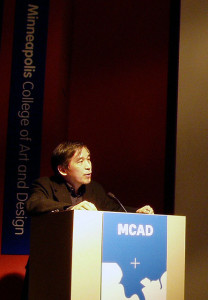This past Sunday the New York Times profiled the Los Angeles cooperative arts-focused station KCHUNG. It isn’t a typical community station, nor is it an LPFM. The station also doesn’t have a license, but it’s not a pirate station.
Instead it operates according to what are generally known as the Part 15 rules, which cover very low-power RF transmissions without a license. These rules cover any electronic device that might emit some kind of radio signal intentionally or unintentionally, from hospital equipment to computers, on any band of the spectrum. The purpose of Part 15 is to put a cap on how much and what kind of radio emissions a device can output, primarily to limit interference with licensed applications.
Part 15 applies to the AM and FM broadcast bands, as well, which is how you can have little FM transmitters for use in your car to wirelessly send your satellite radio or smartphone audio to your in-dash stereo. They were particularly popular before external input jacks and Bluetooth were commonly available. In fact, in 2006 the National Association of Broadcasters complained to the FCC about them, alleging that many models exceeded Part 15 limits.
KCHUNG operates on the AM band where, as the Times article notes, rules permit transmitting up to 100 milliwatts of power. There are also tight restrictions on the size of antenna and the length of the cable between teh transmitter and antenna. According to the Times KHCHUNG’s signal at 1630 AM “is so hyper-local, it can reach a radius of only two or three blocks.” This is pretty typical for a Part 15 compliant AM or FM broadcast.
As I wrote back in 2011, such low-power AM broadcasting can be a little more effective than Part 15 FM. That’s beause the FCC’s FM limits are defined essentially by how powerful the transmission is at 3 meters from the antenna, which puts a pretty hard limit on how far you can broadcast.
A Storied History for Part 15 and Mini-FM
Part 15 unlicensed broadcasting has a long history in the US, while the principle of ultra low-power radio has been put into practice around the world. As recently as three years ago Pacifica station KPFK actively considered creating a network of Part 15 AM transmitters to serve Spanish-speaking audiences in Los Angeles. From 2000–2005 Allston-Brighton Free Radio used one, and sometimes more, legal low-powered AM transmitters to deliver community radio to these Boston neighborhoods.

Tetsuo Kogawa at the Minneapolis College of Art and Design 2004. Photo: Paul Riismandel
Artist and scholar Tetsuo Kogawa promoted the idea of mini-FM in Japan begining in the 1980s. He put on workshops to help people build their own transmitters. He encourages mini-FM broadcasters to leverage the small broadcast radius by throwing “radio parties,” openly inviting local listeners to drop by and participate in broadcasts.
In the early 90s tiny transmitters based on a single integrated circuit became practical; the storied Ramsey FM–10 was the kit that gave many broadcasters got their start. Kogawa’s work influenced a new generation of transmission artists and community radio activists in the US a decade before LPFM became a reality. Kogawa himself was influenced by the Italian Autonomia free micro-radio movement of the 1970s, as he explains in his article “From Mini-FM to Polymorphous Radio.”
By the mid–2000s the proliferation of those aforementioned car transmitters touched off a brief burst of folks hacking their iTrips–principally by opening them up and affixing a longer antenna–to obtain greater range. This sparked a bit of press frenzy about people running mobile pirate stations from their iPods, that died down quickly when the trend failed to materialize into millions of stations across the nation’s highways.
Part 15 Still A Useful Technique
Still, as KCHUNG demonstrates, Part 15 remains a useful approach for broadcasters who aren’t put off by the limited range, or for whom this is actually an advantage. A good reservoir of information about this class of station can be found at Hobby Broadcaster, a site dedicated to “low power AM & FM broadcasting under FCC Part 15 regulations.” It features profiles of more than a dozen Part 15 stations operated by schools, businesses and individuals.
Webmaster Bill DeFelice recently completed an “AM Transmitter Challenge,” helpfully testing six low-power transmitters, ranging in price from $99 to over $1000.
Anyone looking to start a Part 15 station would be well advised to start with a good, rules-compliant transmitter and careful engineering. It can be very easy to exceed the FCC’s limits, which quickly moves your station from legal low-power into pirate radio territory. If someone complains about your souped-up low-power broadcast there’s a chance an FCC enforcement agent may knock on your door.
Beware that just because you can easily buy a transmitter in a store or online doesn’t necessarily mean that it’s actually Part 15 compliant. Last October the FCC upheld an $18,000 fine to Richfield Electronics for selling “The Whole House Tranmitter” which was marketed as a legal low-power transmitter, but exceeded power emission rules. The company said it shipped at least 2,500 of them, but couldn’t track down all the recipients. Caveat emptor.
A Part 15 broadcast could be a nice compliment to an online station, giving it the nice patina of a “real radio station” while potentially serving a few city blocks or a small neighborhood. In a particularly densely populated area a well engineered station could serve dozens of listeners while remaining legal.
The KCHUNG article notes that the station missed last year’s LPFM licensing window, though it doesn’t seem to bother the station’s founder. I suspect that’s because most listners tune in online. But I wonder if the NY Times would pay as much attention to KCHUNG if it didn’t have that real broadcast presence. Thus, another reason why a little Part 15 might spice up an internet station.



